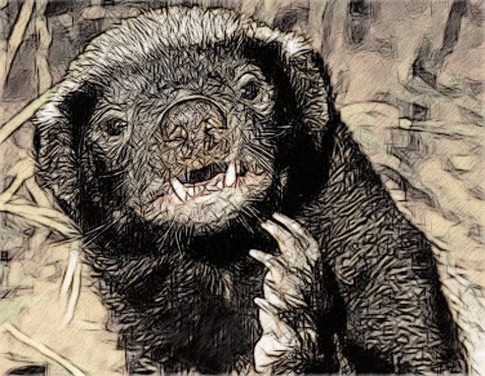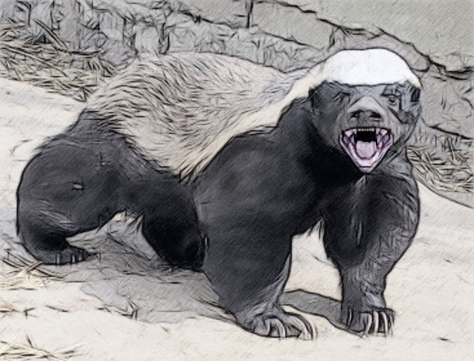
Honey Badgers, the raccoons of the savannah; adept, intelligent, fearless, ferocious with a never give up attitude (South Africa's National Defense Force calls its armored personnel carriers ratels, the Afrikaans word for these beasts). Their scientific name Mellivora capensis means "honey eater of the Cape", it refers to their well-known liking for bee brood and the place where they were first described, The Cape of Good Hope, South Africa. Despite their name, they are related to the weasel family and have skunk-like protection. See the documentary PBS Nature's Honey Badgers—Masters of Mayhem and starting at the 33rd minute in the movie, The Gods Must be Crazy II. In spite of their ferocious attitude, it is hard not to feel affection for these brave, courageous animals—the Honey Badger will take on lions, jackals, hyenas and can sleep off a deadly snake bite. As for porcupines, they are completely ignored.
- The Honey Badger measures 23-28 cm (9.1-11") to its shoulder and 55–77 cm (22–30") in length, with the tail adding another 12–30 cm (4.7–11.8"). Females are smaller than males. Males weigh 9-16 kg (20-35 lb) while females weigh 5-10 kg (11-22 lb) on average.
- The Honey Badger is listed on page 100 of the 2002 Guinness Book of World Records as the most fearless creature in the world.
- Honey Badgers have a very rubbery skin which is about a quarter of an inch thick.

- The skin is so tough that it is impervious to traditionally made arrows and spears and can take a full blow from a machete.
- The thick skin is loose so when caught by a predator it can wriggle and get its teeth and claws in position to attack the face.
- Predators know that while they may kill a Honey Badger they are likely to die in the encounter too.
- Honey Badgers have sharp teeth, very powerful jaws, and they eat every part of their prey.
- The tough little beggars are also immune to many stings and venom. They can get bitten by King Cobras and Puff Adders many times with little effect.
- Not only does it have armoured skin, sharp teeth and claws, immune to poison but it is also very smart. Honey Badgers have been observed using tools to catch prey. Also, they are smart enough to follow Honeyguide birds to find beehives where they’ll eat the larvae and honey.
- The Honey Badger can also emit a strong, stifling odour that they use as a form of defence against large predators like lions.
- Lions and leopards tend to give the Honey Badger a large berth, and they have been seen chasing lions off of a kill taking it for their own. One attack that was observed saw three Honey Badgers chase off seven lions from a kill.
- Honey Badgers are able to dig quickly into hard earth. Within a few minutes they can dig a hole deep enough to hide themselves.
- One particularly vicious tactic the animals use on larger prey is to castrate them and then wait for the animal to weaken from bleeding.
- When attacked by dogs, Honey Badgers scream like bear cubs.